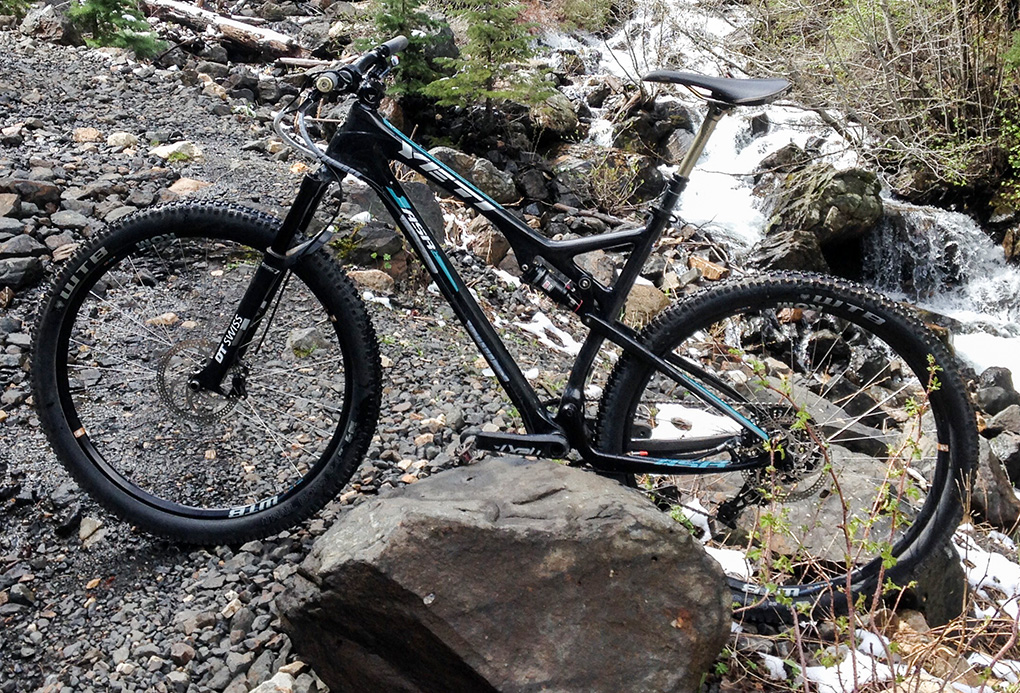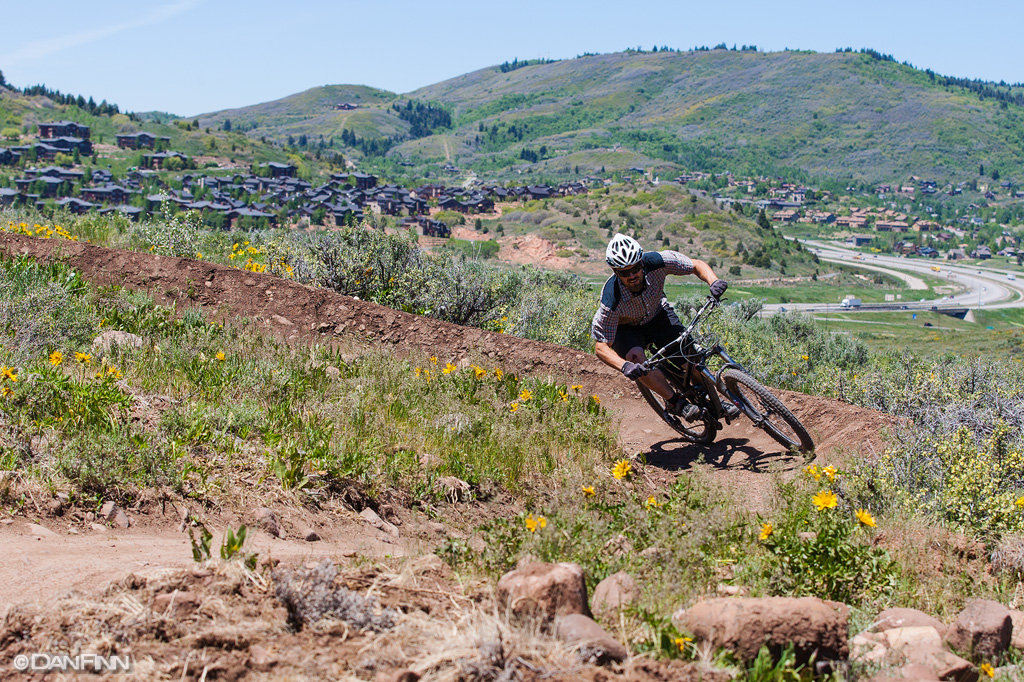[Editor’s Note: When our reviewers aren’t out testing various frames and forks and whatnot, what do their own personal builds look like? Our Reviewers’ Rides series asks some of our riders to detail their setups, and explain why they’ve chosen these particular frames and components.]
Marshal Olson, 6’2″, 210 lbs.
2015 Yeti ASR-C 29, Size XL
I have recently shifted my trail riding emphasis from gravity focused to a more subtle, controlled program. I am looking for overall high speed and efficiency, without sacrificing the ability to charge through rough trail spots. While my showings at the occasional bike race remain only slightly up from mid-pack, it’s really just about riding my bike more, covering more ground, and riding singletrack.
My bike has become focused on 90% of the trail experience: climbing, holding speed on flat sections of trail, and rallying corners.
In the steep, technical, and rough sections that comprise 10% (at most) of my trail time, I rely more on physical riding (i.e. suspension = knees and elbows), and general bike handling skills (I used to ride a lot of trials and rigid mtb’s, and tend to rely on suspension and super slack angles less than some).

Frame: 2015 Yeti ASR-C 29
Size XL,
Seat Tube: 20.5”
Effective Top Tube: 25.7”
Bottom Bracket Height: 13.4”
Reach: 18.2”
I like a stiff frame that will not flex under a heavy pedaling load, and pedals neutrally while climbing and on the flats. The Yeti has a planted and stable feel, with an active suspension platform.
The Build (with links to reviews)
Frame – 2015 Yeti ASR-C 29
Rear Shock – Rockshox Monarch RT3 6.5×1.5
Fork – DT Swiss OPM ODL
Brakes – Sram Guide RSC w/ Formula 180mm SL rotors
Drivetrain – Sram 11spd
Cranks – Race Face Next SL cranks
Pedals – TIME XC8 Pedals:
Cockpit – Race Face SIXC bars, Turbine Stem
Seatpost – Thomson Stealth Post
Grips – ESI Racer’s Edge Grips
Seat – SDG Falcon Ti Seat
Wheels – Sram XO Hubs, Sapim Laser Spokes, WTB KOM i23 Rims
Tires – WTB Trailboss 2.4
Rear Shock
Rockshox Monarch RT3 6.5×1.5: I decided to swap the stock 2015 Fox Float CTD shock out to find something that does not hang up on squared edges quite so much while descending. I find the RT3 to have a more useable range of compression adjustment than the Fox Float CTD.

To me, the CTD feels underdamped in the D position, over damped in the C position, and I could not find a setting to leave it in for the T position.
I feel comfortable riding in any position in the Monarch RT3 range, but generally climb in the Climb setting and descend in the Descent setting.
Fork
DT Swiss OPM ODL: The DT fork might fly under the radar, but it’s a really good fork. Despite having stanchions that are only 32mm in diameter, the fork is stiff, largely due to its crown design.The fork is very sensitive to small bumps, and the damping and spring rate match my needs very well. All in all, this fork absolutely rips, and does it in a package that comes in 300g lighter than the Rockshox Pike I would otherwise be riding on this bike.
Brakes
Sram Guide RSC w/ Formula 180mm SL rotors: These brakes are a nice package: competitively light, affordably priced, great modulation, and excellent power. They are paired with the light, inexpensive, and durable Formula 1pc SL 180mm rotors front and rear.
NEXT: Drivetrain, Cockpit, etc.

Marshal,
You’re a big dude (relative to many cyclists)…any other frames you particularly liked (or disliked). And why? (sizing/flex/etc).
Shawn
Hey Shawn,
Great question. I have had some frame flex issues with older titanium hard tails, and super light steel bikes, but these days when there is a little more frame flex than I might like I just make it up with wheels.
Coming from heavy and very stiff alloy DH bikes, The enduro 29er I rode most of last season was not particularly stiff laterally, but moving away from alloy wheels and switching to wide carbon rims made all the difference and really helped that bike.
The wheels on the Yeti here are super light (1590g @ 29er), but ride great. The overall frame/wheel setup is just a shade less stiff than the enduro with 200g heavier carbon wheels.
I could easily bump the spokes on my current wheelset to alpines and the rims to something like the DT Ex571 and exceed the overall stiffness of the Enduro 29 with carbon wheels. I just have yet to convince myself that it’s worth it at this point.
I am sorry, just re-reading your question, it looks like I incorporated a reply for the lower question into yours, sorry!
for me it’s been a constant progression of bikes since the late 90’s. Some haven’t worked out the way I hoped (ex. moots ybb), and some have very fond memories (m2 sworks, yo eddy). Up until about 2004, I just rode xc bikes, and predominately singlespeeds, and even then I rode the widest handlebars (710mm) and about the shortest stem (100mm) that was available back then. I did learn pretty quick that titanium and marshal were not very compatible due to flex. But steel was great, as was fat chance geometry.
From 2004 to 2011 I rode predominately gravity rigs, and the geo, suspension and handling of bikes changed radically in that window.
It took a couple summers of dropping from 170mm to 160mm to 140mm to finally get comfortable with how insanely capable modern trail bike are, and how irrelevant the actual wheel travel is.
At this point, I feel pretty well settled on a geometry framework that blends a descending oriented background with all day pedaling comfort, but it took a ton of experimentation, and is really only since mid summer last year that I really feel dialed on a trail bike again.
Anyhow, hope that answers your question?
I currently ride a very similar setup on the Northern Colorado Front Range, and I’m looking to upgrade from a 2010 Ellsworth Evolve (alloy) to the 2015 Yeti ASRC. Have you experienced much frame flex? As I’ve started the research, I only came across one warning about bigger riders on this particular bike. I’m 6”4″ and 212 with a pack and probably not as aggressive a descender as yourself (although part of this bike’s allure is its slackened head tube). Thanks for any insight you can offer.
Hi Creighton,
I would be concerned about the stock Stan’s Crest wheels on the ASR build.
As a big guy I would suggest swapping to something like i9 trails or nice hand built wheels.
The frame itself is plenty stiff for how one would ride the bike. It is not stiff enough to slap burms all day, but it’s not for that.
Hope that helps
Hi Marshal,
As a big guy (6’3 215) I always appreciate your comments and reviews, especially this article and your comments in another article on bike fit in relation to reach, chainstays and head angle. Was wondering if you had a chance to ride or had any opinions regarding the Yeti SB4.5c and the Pivot 429trail? Any insights you may have would be appreciated. I’m in Northern California and ride a mixed bag of trails here. Currently on a Cannondale Jekyll 26er
I have a new ASRc on the way and I’m going to set it up with a Monarch RT3. My question for you is did you find what tune is recommended for the Monarch when paired with the ASRc? I see that several stock settings are available and want the best performance for the ASRc. Thanks!
Justin